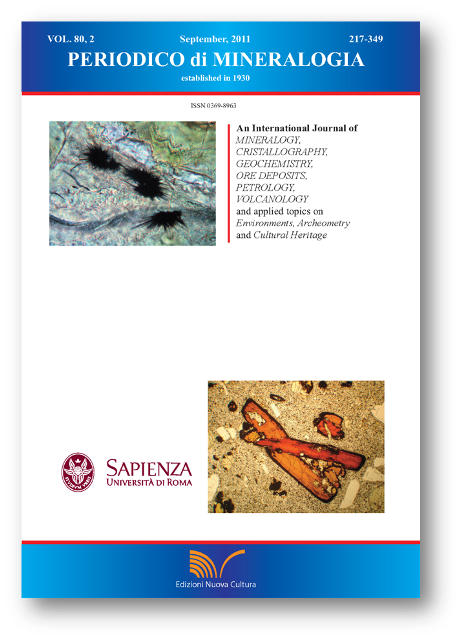Volcanic geology and petrology of the Val Calanna succession (Mt. Etna, Southern Italy): discovery of a new eruptive center
DOI:
https://doi.org/10.2451/2011PM0021Keywords:
Valle del Bove, geological survey, magma differentiation, crystal fractionation, shallow feeding system.Abstract
Periodico di Mineralogia (2011), 80, 2, 287-307 - DOI:10.2451/2011 PM0021
Volcanic geology and petrology of the Val Calanna succession
(Mt. Etna, Southern Italy): discovery of a new eruptive center
Eugenio Nicotra, Carmelo Ferlito, Marco Viccaro* and Renato Cristofolini
Dipartimento di Scienze Geologiche, Università di Catania, Corso Italia 57, I-95129, Catania, Italy
*Corresponding Author: m.viccaro@unict.it
Abstract
A new geological survey of the Val Calanna area at Mt. Etna (the southeastern extension of Valle del Bove, hereafter VdB), along with petrographic and geochemical data, highlighted some differences in the volcanic succession with respect to that previously reported in literature. Our study confirms that the most ancient volcano-stratigraphic Unit of the VdB crops out at Mt. Calanna, recently interpreted as a dyke swarm. The Mt. Calanna Unit is overlain by the 80-m-thick lava succession of the Salto della Giumenta Unit, one of the
Ancient Alkaline Centers. Above this, volcanics of the Mt. Zoccolaro Unit constitute the frame of the present-day homonymous ridge. Mt. Zoccolaro lavas are benmoreites characterized by amphibole megacrysts, showing features similar to those of the Trifoglietto phase (100-60 ka). The eastern portion of the Mt. Zoccolaro edifice is overlain by the volcanic succession of a newly recognized small-sized eruptive Center: the Fior di Cosimo (FdC). The FdC Unit is constituted of a sequence of alternating lavas and pyroclastic deposits which dip radially away from an inferred vent hypothetically located in the middle of Val Calanna. Relationships between major oxides of FdC lavas and their stratigraphic position show an increasing degree
of differentiation through time, from basalts to benmoreites. Simulations of crystal fractionation through MELTS revealed that the most evolved FdC lavas can be derived by subtraction of 32% of ~An66-82 plagioclase, 8% of augitic clinopyroxene, 8 wt% of spinel, 4% of ~Fo68-72 olivine and traces (< 1%) of apatite from a basaltic composition (54% of total solid fractionated). The proposed model for the FdC magmatic evolution is therefore the intrusion of a slightly differentiated magma at shallow crustal levels. Magma supply should have then ceased forming a reservoir that allowed differentiation by crystal fractionation, gradually leading to an increase of the volatile pressure of the system. This favored amphibole crystallization, as observed in the last-emitted products. The available data suggest that FdC can be attributed to a pre-Ellittico eruptive phase.
Key words: Valle del Bove; geological survey; magma differentiation; crystal fractionation; shallow feeding system.


